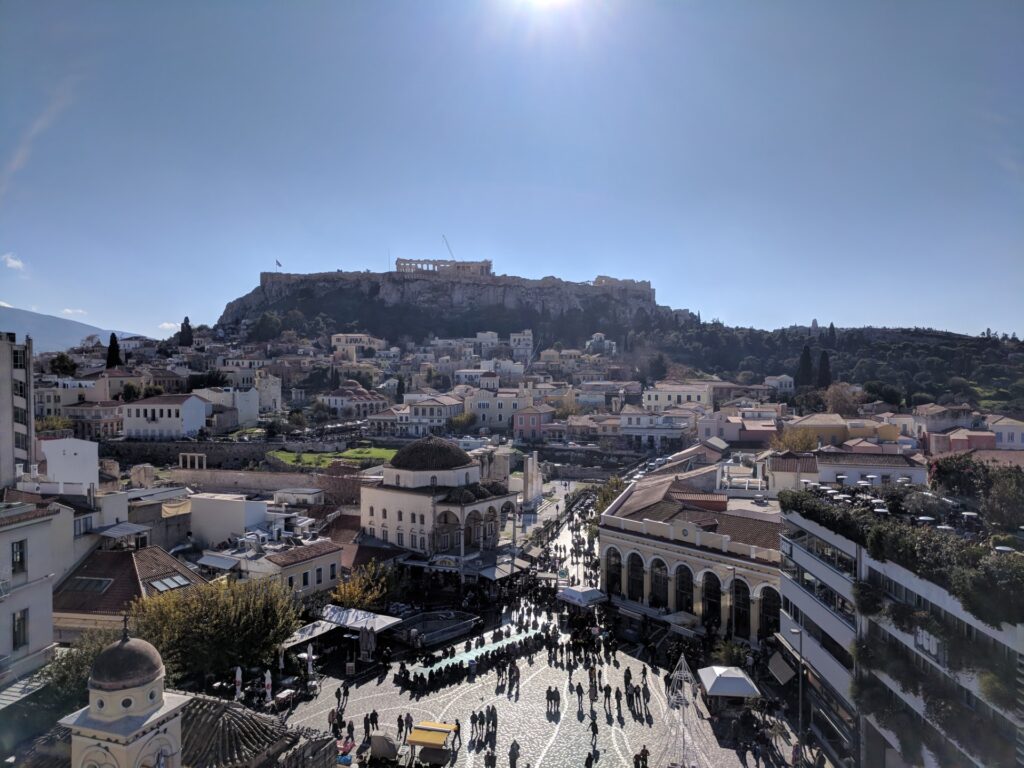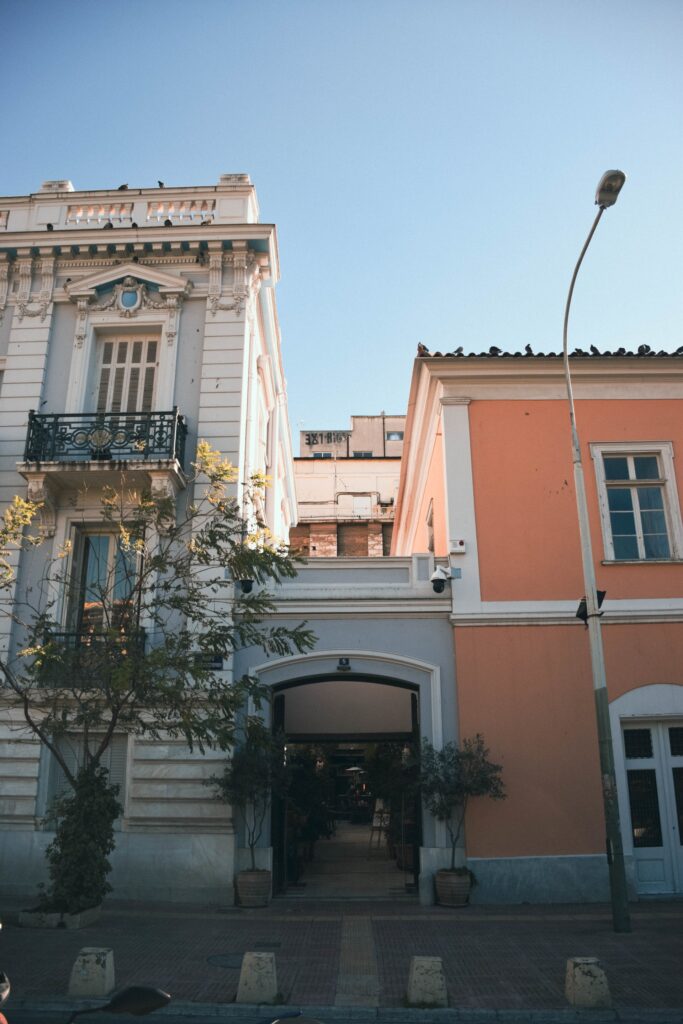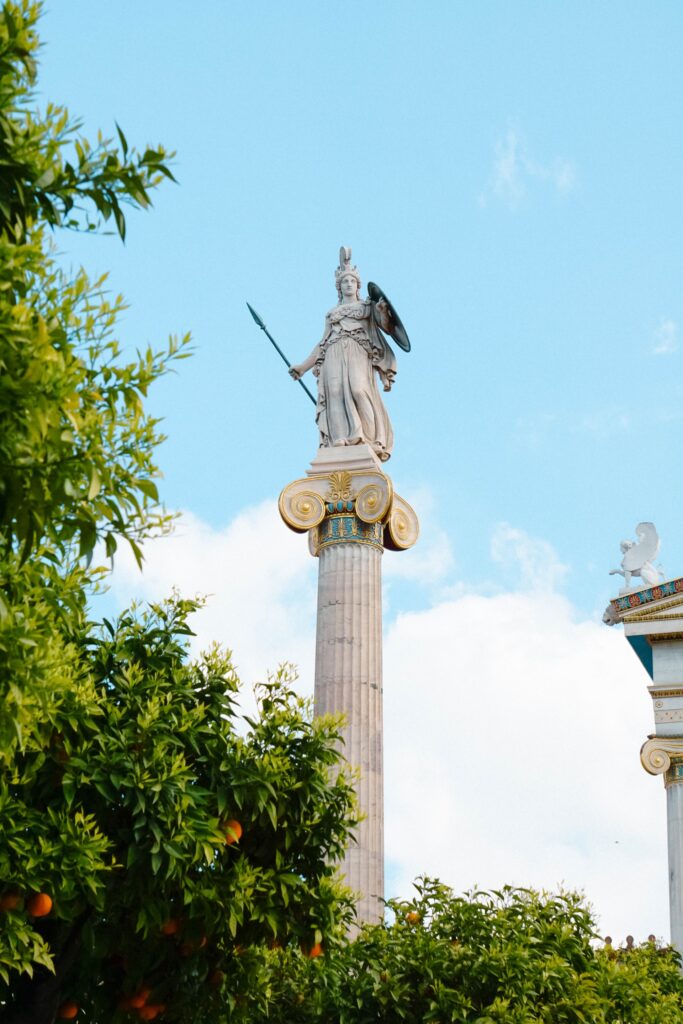By Jeanie WEST
ROOFTOPS have lately caught my attention in the chaotic, vibrant sprawl that is the Greek capital, Athens. I’ve been up close and personal with the eyeline of the stellar Parthenon from the Herodion Hotel in alluring Makrygianni – whose POINT A restaurant dishes up fodder fit for demi-gods – wondering at the panorama from the elevated parking lot crowning the National Museum of Contemporary Art and observing the moon from the balcony of a quiet little bnb in the city centre.

This European capital dedicated to Athena, goddess of wisdom and war, dubbed by John Milton ‘the eye of Greece, mother of arts and eloquence,’ is now much more than a whistle stop overnight portal to the islands. Renaissance burgeons across entrepreneurial, cultural, political and artistic arenas. Revered classical treasures spar with contemporary street art, modern cuisine, a reinvigorated cafe culture, out-there galleries and bars and areas of once enduring poverty resurrected by a creative survival instinct. Tourists these days can expect an eclectic grand tour worthy of Lord Byron, the poet now plastered in graffiti across a high rise in Bohemian Psyri, in the city that claimed his last breath.
On our first evening the dark seizes the day from POINT A’s beautiful elevated eatery as the world famous Greek temple illuminates the skyline. Between us we enjoy tomato kefte stuffed katiki cheese balls, beef tartare with aruga caviare and smoked graviera cheese, a shrimp salad with caramelised hazelnuts and strawberry vinaigrette, seafood carbonara and pork cheeks with baked cauliflower and potatoes. Gulp – it’s a lot! The stylish restaurant is smartly lit, festooned with plants and animated by expert cocktail waiters. The waiting staff are both helpful and knowledgeable. In the wider hotel jacuzzis, a spa, soft beds and cotton sheets so fresh they might have just been down-sailed from the Argo, the ship Jason commandeered to fetch the Golden Hind, have us swooning. Earlier in the library I take to scribbling in my journal; a backgammon set graces one of the tables, and huge ceramic bowls of lemons and green apples sets a fresh and breezy tone. More starkly, a sturdy tree rises up through an atrium restaurant soaked in natural light by day and strewn with flickering candelabra by night.
This is a time of expansiveness in Athens – after years of uncertainty young people are returning and investing their hopes into a new dawn. Post crash, Covid and recent elections, and on the heels of more lasting stability, Athenian lungs are gulping air at a steadier pace. There are bright new restaurants like Annie in central Athens and Linou & Soumpasis & Sia in Psyri, whose artful and minimalist dishes are compelling, innumerable galleries including the recently resuscitated National Museum of Contemporary Art (EMST) – whose focus on art for all is refreshing – and business and building enterprises reimagining a place so recently on its knees. Athens isn’t afraid of change, and tourism, the beating pulse of the Greek economy, knows how to shape-shift to its pace. As extremes of weather intensify, the city’s year-round draw could yet be its salvation.

We map out disparate districts to figure how much ground we can cover in four or five days before scooting off on a wilder adventure to the Pelopponean Mani. That’s the great thing about Athens – it offers two holidays for one as a portal for 6000 islands scattered in the Greek seas. Athens is villagey, and exciting districts include vibrant Plakka, Kerameikos, the historic potters quarters, which holds the biggest cemetery in Greece, trendy Psyri once a down at heel fleapit, now thriving with hip bars, restaurants and lively nightlife, Gazi whose Technopolis converted gasworks contemporary arts space hosts jazz, indie and world music and the anarchic art hub that is Exarcheia, hot spot of political radicalism and intellectual argument.
Before our city explore we skip across to the Argo-Saronic islands from Piraeus, a cosmopolitan port, harbouring immense stories with two million travellers annually crossing boarding planks. The Saronics are a handsome collection of volcanic outcrops where rich Athenians sample a gentler living in step with nature without long haul ferry rides deeper into the Aegaean. Hydra, Spetses, Poros, Aegina and Agistri all retain distinct personalities and we feed off their charisma until early evening.
We sail on the Cosmos run by Keytours, one of the fastest vessels in the fleet. In the VIP suite of the Athens Day Cruise, we are promised “fine dining, top entertainment and exciting destinations.” It is both comfortable and fun. Hydra, famous hang-out of Leonard Cohen and the Beatles, is not disappointing, despite the hoards of day trippers like us rooting around for nostalgia. Sipping espresso at quayside cafes is utterly serene as the saddle-backed working donkeys and harbour labourers do their thing. We saunter through the labyrinthine whitewashed back alleys, quirky and romantic, once home to a colony of artists. They are littered with scrawny stray cats nestled in crates, baskets, or sprawled across the paving flags purring out approval. Tourists keep them alive during the season and their fate later is at the discretion of locals. A couple of ducks (out of water I’d say) waddle surreally up the main street.

In the enchanting back streets we try on clothes and jewellery. We wonder at the interior of Raflia Pharmacy, founded in 1890, a relic of the past, its pine cabinets and porcelain and embossed glass jars filled with healing tales and the great-grandson of the founder still running the show. Hydra’s other wink to the past is the absence of vehicles – banned for years – and a blacksmith for its sentient animal vehicles. Piped water is also yet to be established here – the community relies on tankers to keep them alive.
The vivid, ochre-coloured building on the hillside is Lazaros Kountouriotis Mansion bequeathed by the wealthy ship owner and now an interesting museum dedicated to family history, folklore and art. And right behind the town’s painted and cute facade there are bucolic pine-lined hiking trails and pretty coves and beaches where horse riding treks are possible. Notable beaches include Bisti and Vlychos or more upscale Mandraki Beach Resort – some accessible by water taxi.
Back on board the Cosmos we take a light lunch as we dart across the water to Poros which has a subtler flavour but is no less interesting. The toy town-looking clock tower overlooks steep passageways scented and coloured with bold jasmines, bougainvillaea and nasturtium. Gazing across the majestic Saronic Gulf to the Peloponnese – the air heady, healing and still. I’m impressed with how green this place is. A tiny Greek Orthodox Church is illuminated with prayer candles and the gold iconography of yore. The feeling of the Almighty exudes a little more calm, as if we need it. This sweet little haven has an amphitheatre-style stepped architecture and neoclassical heritage; in the summertime an outdoor cinema dishes up escapism deep into the night. The doric-style Temple of Poseidon between the hills of Vigla and Profitis Ilias, in the north, and the Archaeological Museum of Poros at Koryzi Square, which houses some of its rescued relics and other such ancient wonders are further draws. If you drop anchor for longer be sure to visit the Holy Monastery of Zoodochos Pigi, which dates back to 1728, where contemporary ascetics swing their incense and meditate in little cells. Big fat lemons ripen on the trees and all things bright and beautiful flourish in their colourful gardens. This sacred spot is surrounded by ubiquitous forests, trails and scented aromatic herbs.
And then it’s on to Aegina; a bigger island notable for pistachio nuts which tumble with abandon from the trees. Shops dedicated to their celebrity line the streets. The coach guide spews forth fun facts; we hear an unsettling myth about how Zeus created Myrmidons from the ants on the island. These impressive warriors had six hands and wore black armour and would later fight in the Trojan War as the most fearsome flying unit in Greece. Eek! We amble into the work in progress church of Agios Nekfarior and monastery of Triada (the Holy Trinity). Prayer and hard work were apparently Nekfarior’s thing – indeed many of the faithful hear the saint blessing them and apparently 14 nuns still live and work here. Aegina also holds one of the finest temples in Ancient Greece, the 5th century Temple of Aphaia, which has stunning views of the mainland.
We finish our trip with a celebration of the fruits of the sea – street food style (it seems with half the town’s feline population). Aegina is slap-bang in the middle of Greek fishing’s most central location. We enjoy an embarrassment of riches; white bate, prawns, octopus mostly run through a deep fryer with chips and on the side. We then return to our vessel happy, pockets stuffed with pistachio and honey bars, for light entertainment on the ride back to the mainland
The floating knees-up contrasts with the holy experiences on the islands. An organ player reels out cheesy Greek ditties and a couple of heavy fellas hit the dance floor with authentic folk dance. It’s a laugh watching a shy audience surrender to their impulses and huge fun. We disembark at Piraeus happy and fulfilled with the evening ahead of us.
The Acropolis at night appeals to me – as the moon creeps into early evening. I want to get as close as we can – it’s dreamy. We wander through a famous serene boulevard where buskers and jewellery sellers hawk their wares. The park and marble pathways leading to the temple are steeped in story – surrounded by olive trees you feel locked in the past. In recent months hoards of tourists and epic temperatures have limited footfall to certain times of the day to prevent damage to relics and health.
We steer for a nightcap at Herodion’s sister bistro Gargaretta (gargaretta.gr) which showcases cheese platters, beautiful salads and tapas, as well as Mediterranean inspired main dishes. This elegantly lit, relaxed joint could easily steal the night. Next day we hit Plakka for lunch on its famed steps, take in the markets of Monastireki, a cafe and the colourful bars of PsyrI. At Gazi we check out INO’s pastiche of Leonardo Da Vinci’s Last Supper. The city’s Banksy was commissioned during a fiesta celebrating the Italian master to echo his influence down the centuries. His version of the masterpiece captures political disaffection during a period of deep disquiet. Covid lockdowns gave other graffiti artists freer rein to express themselves in this art form in various neighbourhoods. Many of their giant works push the envelope for democracy.
We can’t leave this mesmeric place without time travelling through the Acropolis Museum (tickets from £19.50 or free on museum days). Lunch in the restaurant is well-presented – and the view is epic. We sigh at evidence of the everyday; the children’s toys and women’s make up pots, all excavated from these splendid ruins dating back to five centuries BC.
Here is Athens – unvarnished and updated – as John Milton wrote “the eye of Greece, mother of arts and eloquence.” His lofty observations remain as on point as ever.






